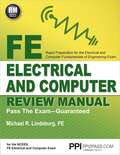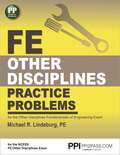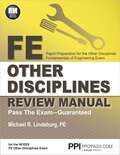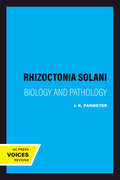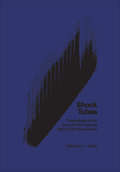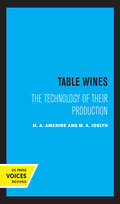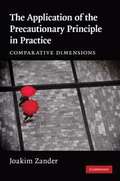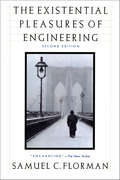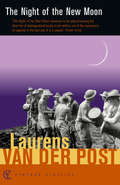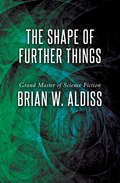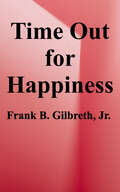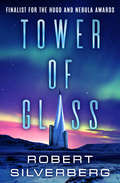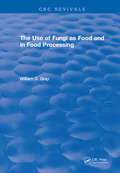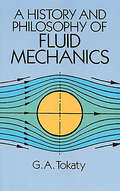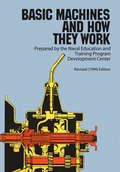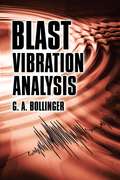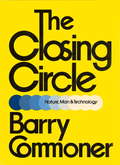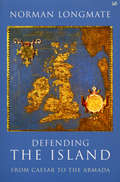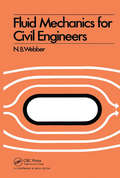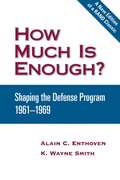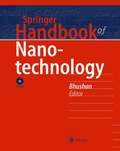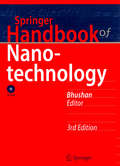- Table View
- List View
PPI FE Electrical and Computer Review Manual eText - 1 Year
by Michael R. Lindeburg PEMichael R. Lindeburg PE&’s FE Electrical and Computer Review Manual offers complete coverage to Electrical and Computer FE exam knowledge areas and the relevant elements—equations, figures, and tables—from the NCEES FE Reference Handbook. With 15 mini-exams to assess your grasp of the exam&’s knowledge areas, and concise explanations of thousands of equations and hundreds of figures and tables, the Review Manual contains everything you need you succeed on the Electrical and Computer FE exam.The Review Manual organizes the Handbook elements logically, grouping related concepts that the Handbook has in disparate locations. All Handbook elements are shown in blue for easy identification. Equations and their associated variations and values are clearly presented. Descriptions are succinct and supported by exam-like example problems, with step-by-step solutions to reinforce the theory and application of fundamental concepts. Thousands of terms are indexed to facilitate cross-referencing. Use the Review Manual in your FE Electrical and Computer exam preparation and get the power to pass the first time—guaranteed. Topics CoveredCircuit Analysis and Linear SystemsCommunications and Signal ProcessingComputer Networks and SystemsControl SystemsDigital SystemsElectromagneticsElectronicsEngineering EconomicsEngineering SciencesEthics and Professional PracticeMathematicsPowerProbability and StatisticsProperties of Electrical MaterialsSoftware DevelopmentKey Features:Complete coverage of all exam knowledge areas.Equations, figures, and tables of the NCEES FE Reference Handbook to familiarize you with the reference you&’ll have on exam day.Concise explanations supported by exam-like example problems, with step-by-step solutions to reinforce the theory and application of fundamental concepts.A robust index with thousands of terms to facilitate referencing.Binding: PaperbackPPI, A Kaplan Company
PPI FE Other Disciplines Practice Problems eText - 1 Year
by Michael R. Lindeburg PEFE Other Disciplines Practice Problems offers comprehensive practice for the NCEES Other Disciplines FE exam. This book is part of a comprehensive learning management system designed to help you pass the FE exam the first time.Exam Topics CoveredChemistryDynamicsElectricity, Power, and MagnetismEngineering EconomicsEthics and Professional PracticeFluid Mechanics and Dynamics of Gases and LiquidsHeat, Mass, and Energy TransferInstrumentation and Data AcquisitionMaterials ScienceMathematics and Advanced Engineering MathematicsStaticsStrength of MaterialsProbability and StatisticsSafety, Health, and EnvironmentKey Features:Over 320 three-minute, multiple-choice, exam-like practice problems to illustrate the type of problems you&’ll encounter during the exam.Clear, complete, and easy-to-follow solutions to deepen your understanding of all knowledge areas covered in the exam.Step-by-step calculations using equations and nomenclature from the NCEES FE Reference Handbook to familiarize you with the reference you&’ll have on exam day.Binding: PaperbackPublisher: PPI, A Kaplan Company
PPI FE Other Disciplines Review Manual eText - 1 Year
by Michael R. Lindeburg PEMichael R. Lindeburg PE&’s FE Other Disciplines Review Manual offers complete review for the FE Other Disciplines exam.Topics CoveredChemistryDynamicsElectricity, Power, and MagnetismEngineering EconomicsEthics and Professional PracticeFluid Mechanics and Dynamics of Gases and LiquidsHeat, Mass, and Energy TransferInstrumentation and Data AcquisitionMaterials ScienceMathematics and Advanced Engineering MathematicsProbability and StatisticsSafety, Health, and EnvironmentStaticsStrength of Materials Key Features: Complete coverage of all exam knowledge areas.Updated equations, figures, and tables for version 9.4 of the NCEES FE Reference Handbook to familiarize you with the reference you&’ll use on exam day.Concise explanations supported by exam-like example problems, with step-by-step solutions to reinforce the theory and application of fundamental concepts.A robust index with thousands of terms to facilitate referencing.Binding: PaperbackPublisher: PPI, A Kaplan Company
Rhizoctonia Solani: Biology and Pathology
by John R. ParmeterThis title is part of UC Press's Voices Revived program, which commemorates University of California Press’s mission to seek out and cultivate the brightest minds and give them voice, reach, and impact. Drawing on a backlist dating to 1893, Voices Revived makes high-quality, peer-reviewed scholarship accessible once again using print-on-demand technology. This title was originally published in 1970.This title is part of UC Press's Voices Revived program, which commemorates University of California Press’s mission to seek out and cultivate the brightest minds and give them voice, reach, and impact. Drawing on a backlist dating to 1893, Voices Revived</DIV
Scottish Locomotive History: 1831-1923 (Routledge Library Editions: Scotland #12)
by Campbell HighetOriginally published in 1970, this volume is a valuable source of extensive data concerning Scotland’s railways and locomotives. Material that has appeared in books, technical journals, society and institutional proceedings is here gathered together, enabling the reader to easily trace details of design and construction on the five main railways of Scotland from 1831 until 1923 when all the railways in Britain came together under English control. As well as being of interest to engineers, this volume will also appeal to railway and social historians.
Shock Tubes: Proceedings of the Seventh International Shock Tube Symposium held at University of Toronto, Toronto, Canada 23-25 June 1969
by Irving Israel GlassThis volume contains the proceedings of a symposium held at the University of Toronto in June 1969. The symposium consisted of six sessions; each containing an invited paper, followed by six contributed papers reporting on recent, relevant research and development. The topics are: a review of research problems in basic shock tube flows and the possibilities for the shock tube in the future; driving techniques; explosive drivers; theoretical and experimental research in electromagnetic shock tubes; chemical kinetics and spectroscopy; and a review of shock tube diagnostics, instrumentation and fundamental data as well as the measurement of physical quantities.
Table Wines: The Technology of Their Production
by M. A. Amerine M.A. JoslynThis title is part of UC Press's Voices Revived program, which commemorates University of California Press’s mission to seek out and cultivate the brightest minds and give them voice, reach, and impact. Drawing on a backlist dating to 1893, Voices Revived makes high-quality, peer-reviewed scholarship accessible once again using print-on-demand technology. This title was originally published in 1970.
The Application of the Precautionary Principle in Practice
by Joakim ZanderThis overview of the role played by the precautionary principle in international trade law, European law and national law compares how precautionary considerations have been applied in the fields of pesticide regulation and the regulation of base stations for mobile telephones in Sweden, the UK and the US. A number of problems in the current application of the precautionary principle are identified and discussed. For example, it is shown that a firm reliance on a wide and open-ended precautionary principle may lead to problems with the consistency, foreseeability, effectiveness and efficiency of measures intended to reduce environmental or health risks. It is suggested that the precautionary principle indeed may be an important tool, but that in order to be acceptable it must be coupled with strong requirements on the performance of risk assessments, cost/benefit analyses and risk trade-off analyses.
The Existential Pleasures of Engineering
by Samuel C. FlormanA classic examination of how engineers think and feel about their profession and its philosophy.“A useful read for engineers given to self-scrutiny, and a stimulating one for the layman interested in the ancient schism between machines and men’s souls.” —TimeHumans have always sought to change their environment, building houses, monuments, temples, and roads. In the process, they have remade the fabric of the world into newly functional objects that are also works of art to be admired. Now as engineering plays an increasingly important role in the world while coming under attack for all manner of sins, one must wonder about the nature of the engineering experience in our time.In this, the second edition of his popular Existential Pleasures of Engineering, Samuel Florman perceptively explores how engineers think and feel about their profession. Dispelling the myth that engineering is cold and passionless, Florman celebrates it as something vital and alive. He views engineering as a response to some of our deepest impulses, rich in spiritual and sensual rewards. Opposing the “antitechnology” stance, Florman brilliantly emerges with a more practical, creative, and fun philosophy of engineering that boasts pride in his craft.First published in 1976, this classic book is essential reading for anyone curious about what wonders we have wrought.“Gracefully written . . . refreshing and highly infectious enthusiasm . . . imaginatively engineered.” —The New York Times Book Review
The Night Of The New Moon
by Sir Laurens Van Der PostThis book is the remarkable story of his experiences in the prison camp, but it is also a meditation on the morality of the Bomb, a compassionate and moving contemplation of human violence.
The Shape of Further Things
by Brian W. AldissThe sci-fi author behind Steven Spielberg&’s A.I. shares his thoughts on the present, the future, and his own work and life. &“We are infinitely rich, yet we mess about with penny-in-the-slot machines,&” writes Brian W. Aldiss in this autobiographical work written over the course of one month. From his Oxfordshire home, he ruminates on dreams, education, the role of technology in our lives, the rise and function of science fiction, and a variety of other topics. The Shape of Further Things is a window into the life and mind of a Science Fiction Grand Master. Winner of two Hugo Awards, one Nebula Award, and named a Grand Master by the Science Fiction Writers of America, Brian W. Aldiss challenged readers&’ minds for over fifty years with literate, thought-provoking, and inventive science fiction. &“This short book flows with large ideas, a time capsule now from the grandest of writers.&” —SF Site
Time Out for Happiness
by Frank B. Gilbreth"Frank Gilbreth chronicles the extraordinary partnership of his parents, which produced not only a dozen children but landmark contributions in the field of scientific management. His story follows Lillie Gilbreth from her childhood in Oakland, California, through her commencement day speech at Berkeley (at a time when few women attended college) to the day in Boston where the slim, shy girl from the West met the big, brash, and bluster Easterner who ran a successful contracting business and dabbled in time and motion studies."
Tower of Glass (Gateway Essentials)
by Robert SilverbergFrom the Hugo and Nebula Award–winning author: &“High adventure, considerable tension, and—most important—social consciousness&” (Harlan Ellison). Simeon Krug is the king of the universe. A self-made man, he is the Bill Gates of the era, having built a megacommercial empire on the backs of his products: androids, genetically engineered human slaves. Having amassed incredible wealth, his next major goal is to communicate with aliens living in an uninhabitable world, sending a mysterious signal. This requires building a mile high tower in the arctic tundra. The androids want civil equality with humans, but are divided on the best means to the goal—political agitation or religious devotion to Krug, their creator. And Krug&’s son, Manuel, is reluctant to step into his role as heir to his father&’s empire.
Use Of Fungi As Food: Volume 1 (Crc Monoscience Ser.)
by William D GrayThe present work is an attempt to bring together in some sort of organized form all such information that would link mycology (other than the involvement of fungi in food spoilage) to the food industry. It may be justly criticized for its brevity and, in some instances, will probably be criticized the philosophy expressed. For this the writer makes no apologies. In the first instance, the present discussion is by no means intended to be an exhaustive treatment of the subject. On the contrary, if it serves in some small measure to alert the student to the vast potential resident in fungi, its purpose will have been served.
A History and Philosophy of Fluid Mechanics (Dover Books on Aeronautical Engineering)
by G. A. TokatyThrough the centuries, the intricacies of fluid mechanics -- the study of the laws of motion and fluids in motion -- have occupied many of history's greatest minds. In this pioneering account, a distinguished aeronautical scientist presents a history of fluid mechanics focusing on the achievements of the pioneering scientists and thinkers whose inspirations and experiments lay behind the evolution of such disparate devices as irrigation lifts, ocean liners, windmills, fireworks and spacecraft.The author first presents the basics of fluid mechanics, then explores the advances made through the work of such gifted thinkers as Plato, Aristotle, da Vinci, Galileo, Pascal, Newton, Bernoulli, Euler, Lagrange, Ernst Mach and other scientists of the 20th century. Especially important for its illuminating comparison of the development of fluid mechanics in the former Soviet Union with that in the West, the book concludes with studies of transsonic compressibility and aerodynamics, supersonic fluid mechanics, hypersonic gas dynamics and the universal matter-energy continuity. Professor G. A. Tokaty has headed the prestigious Aeronautical Research Laboratory at the Zhukovsky Academy of Aeronautics in Moscow, and has taught at the University of California, Los Angeles. He is Emeritus Professor of Aeronautics and Space Technology, The City University, London.
Australian Precious Opal
by Archie KalokerinosThe magnificent splendour of the Australian opal that has fascinated the world for almost a century is still clad in a mysterious veil of fear and superstition whose only explanation is the lack of knowledge. This book attempts to clear the cloud to some extent to the enjoyment of the readers.
Basic Machines and How They Work
by Naval EducationThis revised edition of an extremely clear Navy training manual leaves nothing to be desired in its presentation. Thorough in its coverage of basic theory, from the lever and inclined plane to internal combustion engines and power trains, it requires nothing more than an understanding of the most elementary mathematics. Beginning with the simplest of machines — the lever — the text proceeds to discussions of the block and tackle (pulleys and hoists), wheel and axle, the inclined plane and the wedge, the screw, and different types of gears (simple, spur, bevel, herringbone, spiral, worm, etc.). A chapter on the concept of work discusses the measurement of work, friction, and efficiency; this is followed by investigations of power, force, and pressure, with explanations of the uses of scales, balances, gauges, and barometers. The fundamentals of hydrostatic and hydraulic machines (such as the hydraulic braking system and the hydraulic press) are discussed in detail. The remaining chapters cover machine elements (bearings and springs), basic mechanisms (gear differential, couplings, cams, clutches), the internal combustion engine and power trains (including explanations of various transmission systems — synchromesh, auxiliary, etc.). Every concept is clearly defined, and discussions always build easily from elementary theory to specific applications familiar to anyone with the slightest interest in mechanics. Important concepts, machine components, and techniques are clearly illustrated in more than 200 diagrams, drawings, and cross-sections that reveal inner workings — all of these help to clarify even further an already clear and well-organized presentation. Although it was originally designed for use in U.S. Naval Training Schools, this book can be used to great advantage as a basic text in mechanical engineering in standard technical schools, and it will be immensely valuable even to lay readers who desire a basic knowledge of mechanics.
Blast Vibration Analysis (Dover Books on Engineering)
by G. A. BollingerFor the comprehension and analysis of blast vibrations, scientists and engineers require a sophisticated understanding of wave phenomena. Blast Vibration Analysis makes an important contribution to studies of the subject by focusing on the origin, transmission, and types of elastic wave in solid media. The approach covers physical laws involved in wave analysis as well as the mathematical tools needed to specify and analyze the variety of wave phenomena encountered in nature.G. A. Bollinger, a former professor of geophysics at Virginia Polytechnic Institute and State University, applies the analytical tools that have been so highly refined in earthquake engineering, earthquake seismology, and seismic exploration for petroleum — i.e., digital and spectral analyses — to the blast vibration problem. The text starts at an elementary level, carries the exposition to an intermediate level, and indicates the direction of more advanced consideration. Many informative tables, figures, graphs, charts, mathematical examples, and photographs of instruments appear throughout. Advanced undergraduate students, graduate students, and professionals in engineering and physics will find this treatment stimulating and suggestive of further areas of study and practice.
Closing Circle
by Barry CommonerFrom Chapter One:This book . . . begins with the ecosphere, the setting in which civilization has done its great--and terrible--deeds. Then it moves to a description of some of the damage we have done to the ecosphere--to the air, the water, the soil. However, by now such horror stories of environmental destruction are familiar, even tiresome. Much less clear is what we need to learn from them, and so I have chosen less to shed tears for our past mistakes than to try to understand them. Most of this book is an effort to discover which human acts have broken the circle of life, and why. I trace the environmental crisis from its overt manifestations in the ecosphere to the ecological stresses which they reflect, to the faults in productive technology--and in its scientific background--that generate these stresses, and finally to the economic, social, and political forces which have driven us down this self-destructive course. All this in the hope--and expectation--that once we understand the origins of the environmental crisis, we can begin to manage the huge undertaking of surviving it.
Defending The Island: From Caesar to the Armada
by Norman LongmateIn a brilliantly imaginative blend of military, social and diplomatic history, Norman Longmate retells our island story from the perspective of its defenders, in a narrative which stretches from the Celtic tribes who unsuccessfully fought against Ceasar to the great seabourne defence against the Armada of Philip of Spain. He has gone back to the original sources and investigated the original battlegrounds and weak spots in Britain's defences. But the real strength of his book is its seamless narrative of history, which uncovers the truth behind the legends. A mass of solidly researched fact, not readily found elsewhere, is seasoned with lively, humorous and occassionally gruesome anecdote. The result, providing at once an invaluable sourcebook for the specialist and an enthralling narrative for the general reader, is by far the most comprehensive and accessible history of England versus invasion ever published.
Fluid Mechanics for Civil Engineers: SI edition
by N.B. WebberThis well-established text book fills the gap between the general texts on fluid mechanics and the highly specialised volumes on hydraulic engineering.It covers all aspects of hydraulic science normally dealt with in a civil engineering degree course and will be as useful to the engineer in practice as it is to the student and the teacher.
How Much Is Enough?
by K. Wayne Smith Alain C. EnthovenOriginally published in 1971, and now published with a new foreword, this is a book of enduring value and lasting relevance. The authors detail the application, history, and controversies surrounding the Planning, Programming, and Budgeting System (PPBS), used to evaluate military needs and to choose among alternatives for meeting those needs.
Mrs. Frisby and the Rats of Nimh: 50th Anniversary Edition (Literature Unit Ser.literature Unit Seriesliterature Units)
by Robert C. O'BrienSome extraordinary rats come to the aid of a mouse family in this Newbery Medal Award–winning classic by notable children&’s author Robert C. O&’Brien.Mrs. Frisby, a widowed mouse with four small children, is faced with a terrible problem. She must move her family to their summer quarters immediately, or face almost certain death. But her youngest son, Timothy, lies ill with pneumonia and must not be moved. Fortunately, she encounters the rats of NIMH, an extraordinary breed of highly intelligent creatures, who come up with a brilliant solution to her dilemma. And Mrs. Frisby in turn renders them a great service.
Springer Handbook of Nanotechnology
by Bharat BhushanThis major work has established itself as the definitive reference in the nanoscience and nanotechnology area in one volume. In presents nanostructures, micro/nanofabrication, and micro/nanodevices. Special emphasis is on scanning probe microscopy, nanotribology and nanomechanics, molecularly thick films, industrial applications and microdevice reliability, and on social aspects. Reflecting further developments, the new edition has grown from six to eight parts. The latest information is added to fields such as bionanotechnology, nanorobotics, and NEMS/MEMS reliability. This classic reference book is orchestrated by a highly experienced editor and written by a team of distinguished experts for those learning about the field of nanotechnology.
Springer Handbook of Nanotechnology
by Bharat BhushanThis major work has established itself as the definitive reference in the nanoscience and nanotechnology area in one volume. In presents nanostructures, micro/nanofabrication, and micro/nanodevices. Special emphasis is on scanning probe microscopy, nanotribology and nanomechanics, molecularly thick films, industrial applications and microdevice reliability, and on social aspects. Reflecting further developments, the new edition has grown from six to eight parts. The latest information is added to fields such as bionanotechnology, nanorobotics, and NEMS/MEMS reliability. This classic reference book is orchestrated by a highly experienced editor and written by a team of distinguished experts for those learning about the field of nanotechnology.
